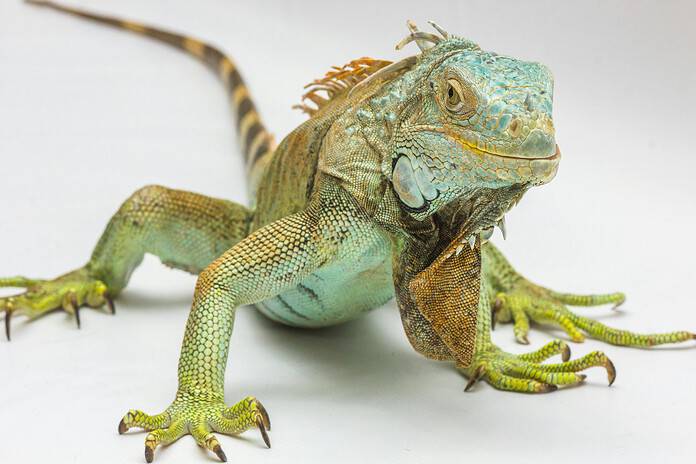Just returning from South Florida recently after participating in the Florida Python Challenge, I wanted to tell you about a side trip I took from the Everglades to hunt the invasive green iguanas in Miami. It’s always a trip I look forward to as it’s beneficial to the local communities to cull the destructive, invasives, with the huge bonus of them being delicious! Yeah, I know, nothing that ugly can taste good right? Well, if that’s what you’re thinking, you’ll be pleasantly surprised if you ever get a chance to try them. If you do, it’ll likely entice you to grab an air rifle and take off after them yourself.
Green iguanas are large lizards from the iguanid family. In Florida, there are three species of iguana: the green iguana, the Mexican spiny-tailed iguana, and the black spiny-tailed iguana. All green iguanas share several identifying characteristics that differentiate them from the other species. The easiest characteristic to look for is a barred tail. Green iguana bars are typically black in color but can vary slightly depending on the overall shade and pattern of the iguana. They also have a row of spikes leading from the base of the head to the tail. These spikes are prominent and easily distinguishable from other large lizards found in Florida, like monitors.
Now, contrary to their name, not all green iguanas are green. They range green in color from bright green to muted shades of gray or brown in color. Males will range in size from two to nearly six feet in length. As they grow larger, males will display an orange or pinkish coloration. Both sexes also have a throat flap or dewlap. On males, this flap is noticeably larger to attract females and ward off predators.
Like most critters in Florida, the green iguana is not native. Way back in the 1960s, the first iguanas made their way to Florida, likely as hitchhikers on cargo ships. These first sightings were isolated to Dade County near Miami and Hialeah.
Since their introduction, populations have exploded in size. They’re now found throughout South Florida, steadily extending their range north. The highest densities exist along the coast, with smaller populations throughout central South Florida. Iguanas are burrowing creatures, meaning they live in holes they dig.
Look for rocky outcroppings, canal banks, and drainage pipes, and chances are you will find an iguana or two. But, they also thrive in urban settings and are readily found in neighborhoods and city developments. Just be absolutely certain to get the landowner’s permission before you attempt to take any of the suburban lizards. Not doing so can cause you a heap of trouble, which is best avoided.
The iguanas are diurnal and during the day they will leave their burrows in search of food and sun. Like all reptiles, they are cold-blooded, meaning they use sunlight to regulate their body temperature. When they aren’t sunning themselves, they are likely looking for food. They have a mixed diet mostly of fruit, plants, small insects, and eggs. They are also incredibly good climbers, so be sure to look for them in trees, bushes, and even on roofs when hunting them.
For this last hunt, I was joined by my good friend Sean Cummins and his daughter Bristol. It was great fun with lots of shooting. We didn’t get to spend the full day chasing them, as we had to return to the Glades for the nighttime python hunt, but the cooler wasn’t empty! The meat will be a fine treat on the grill and Sean even saved a skin to tan himself, rather than to sell them at an average of four dollars each. It turns out, with directions from Noted taxidermist Allison Doty, it was an easy process and the skin turned out soft and pliable. We’ll be doing a lot more of that in order to make ourselves a variety of leather crafts using the iguana skins.
For more information on iguana hunting or how to tan your skins, reach out to me at [email protected]. God Bless, and good hunting!
Toby Benoit is a best selling novelist and professional outdoors-man with thirty-five years of experience guiding and outfitting for big game all across America. Toby is a renowned archer and turkey hunting expert who manufactures custom game calls and is a regular judge at NWTF sanctioned turkey calling events across the Southeast.
![Ariel Dixon, of Brooksville poses with an invasive green iguana taken on a hunting trip in Miami.
[Photo by Toby Benoit]](https://www.hernandosun.com/wp-content/uploads/2024/09/Screenshot_20240818-233714.png)
[Photo by Toby Benoit]

